This article needs additional citations for verification .(October 2008) |
| German Rex | |
|---|---|
 | |
| Common nicknames | Rex |
| Origin | |
| Breed standards | |
| FIFe | standard |
| Domestic cat (Felis catus) | |
The German Rex is a breed of domestic cat.
This article needs additional citations for verification .(October 2008) |
| German Rex | |
|---|---|
 | |
| Common nicknames | Rex |
| Origin | |
| Breed standards | |
| FIFe | standard |
| Domestic cat (Felis catus) | |
The German Rex is a breed of domestic cat.
The German Rex is a medium-sized breed with slender legs of a medium length. The head is round with well-developed cheeks and large, open ears. The eyes are of medium size in colours related to the coat colour. The coat is silky and short with a tendency to curl. The whiskers also curl, though less strongly than in the Cornish Rex. They may be nearly straight. All colours of coat, including white, are allowed. The body development is heavier than in the Cornish Rex - more like the European Shorthairs.
A German Rex cat is very friendly and quickly bonds with its human. It is lively, playful, and intelligent. Its temperament is much the same as a Cornish Rex.
An early Rex-type cat from Germany was Kater Munk, a cat of the family of one Erna Schneider, that was born 1930 or 1931 in a village near then-Königsberg, German Reich (today's Kaliningrad, Russia). Munk was the son of a mahogany [1] [2] Angora cat and a Russian Blue. There were one (some sources say two) other curly cat(s) in the litter which was castrated early. Munk spread his genes plentifully among the village's cat population till his death in 1944 or 1945. The Schneiders valued the strong tom with a penchant for catching fish from the family's garden pond for himself, not for his curly coat; he was, it seems, referred to colloquially as a Preußig Rex ("Prussian Rex", in local dialect).[ citation needed ] German Rex researchers do not consider Kater Munk to be related to the German Rex breed [3] and state that he was never bred.
In the summer of 1951, a doctor in Berlin-Buch (Pankow borough), Rose Scheuer-Karpin, noticed a black curly-coated cat in the Hufelandklinik hospital garden. The clinic's personnel told her that they had known the cat since 1947. The doctor named the cat Lämmchen (German for "little lamb"). Her supposition that she must be the result of a mutation, was shown to be correct. Thus Lämmchen was the first breeder-owned Rex-type cat and the maternal ancestor of all the current German Rex.
The first two German Rex deliberately bred were two Rex kittens from a 1957 litter of four, offspring of Lämmchen and the straight-coated son Fridolin she had with a stray black tom Blackie adopted by Scheuer-Karpin. Lämmchen died on December 19, 1964, or in 1967, indicating she had been very young when first sighted in 1947. She left a number of Rex and crossbred descendants - the last one of her offspring was born in 1962 - most of which were used to improve other breeds such as the Cornish Rex which was suffering from skin problems due to being descended from genetically impoverished thoroughbred stock. In 1968, the lineage hinged on the efforts of the GDR cattery vom Grund who acquired the last 3 Rex offspring of Lämmchen not sold abroad, and amplified the lineage with European Shorthair and mixed-breeds. A stock was established in the West through the efforts of the FRG von Zeitz cattery in 1973 which in the previous year had acquired their sample of the allele with the white female crossbred Silke vom Grund. After some years, the breed slowly became more plentiful.
Another Rex cat turned up in Berlin-Buch, apparently in the late 1950s. The tom named Schnurzel eventually contributed to German Rex breeding; it is not known how he related to Lämmchen but presumably he was a grandson of hers, as Scheuer-Karpin would let her cats roam free through the gardens and forests of Buch. Even in more recent times, the genetic legacy of Lämmchen if not Munk manifests itself on occasion in the Berlin area, such as Pumina, found as a stray inage of Preuss from Siegburg which turned up in 1979 in the Rhineland town of Siegburg does not appear to be related to be a German Rex proper; it is almost certainly not related to Lämmchen. Nonetheless, his descendants may have contributed to the German Rex lineage of today.
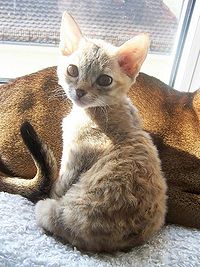
It is not certainly known how Lämmchen relates to Munk, only that the German Rex mutation - on the same gene as in the Cornish Rex - is recessive, meaning it will only show when both alleles are "Rex", and that Munk is the first thoroughly documented Rex cat, though as stories of "children cuddling curly coated kittens" [1] attest, Rex alleles turn up every now and then. Presumably, Munk sired many offspring with local cats, none of which would have had curly fur as the allele of Munk's straight-haired mates would dominate. In the following years, any curly-haired cats in the Königsberg area went unnoticed or at least were not bred on purpose; the allele nonetheless would have stood good chances to remain in the local cat population, as recessive alleles have a very low probability to disappear entirely.

The Cornish Rex is a breed of domestic cat. The Cornish Rex has no hair except for down hair. Most breeds of cat have three different types of hair in their coats: the outer fur or "guard hairs", a middle layer called the "awn hair"; and the down hair or undercoat, which is very fine and about 1 cm long. Cornish Rexes only have the undercoat. Occasional individuals are prone to hair loss or will develop a very thin coat or even go bald over large parts of their body. The curl in their fur is caused by a different mutation and gene than that of the Devon Rex. The breed originated in Cornwall, Great Britain.

A show cat is one that has been judged to be close to the physical ideal for its breed standard at a cat show. Not all pedigreed cats are show cats, many are just pets but the ones with the best conformation and personality are often shown in associations such as the CFA and TICA in the US, the GCCF in the UK or the FiFe in the rest of Europe. Uncommonly, a prize-winning pedigreed show cat can be worth thousands of dollars but most are loved pets. In order to compare examples of breeds and improve stock, cat shows are held where judges evaluate the cats according to a breed standard. Pedigreed cats are often identified with microchip implants.
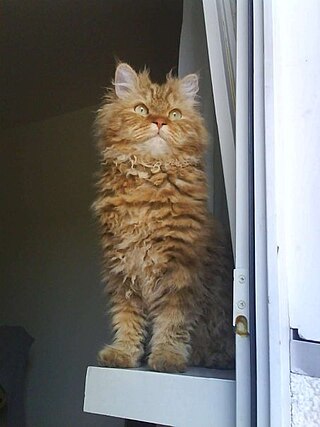
The Selkirk Rex is a breed of cat with highly curled hair.

The Sphynx cat also known as the Canadian Sphynx, is a breed of cat known for its lack of fur. Hairlessness in cats is a naturally occurring genetic mutation, and the Sphynx was developed through selective breeding of these animals, starting in the 1960s.

The Russian Blue cat, commonly referred to as just Russian Blue, is a cat breed with colors that vary from a light shimmering silver to a darker, slate grey. The short, dense coat, which stands out from the body, has been the breed's hallmark for more than a century.

The Havana Brown was the result of a planned breeding between Siamese and domestic black cats, by a group of cat fanciers in England, in the 1950s. Early breeders introduced a Siamese type Russian Blue into their breeding. However, using current genetic testing, it is believed that almost none remain in the gene pool.

Cat coat genetics determine the coloration, pattern, length, and texture of feline fur. The variations among cat coats are physical properties and should not be confused with cat breeds. A cat may display the coat of a certain breed without actually being that breed. For example, a Neva Masquerade could wear point coloration, the stereotypical coat of a Siamese.

The Oriental Shorthair is a breed of domestic cat that is developed from and closely related to the Siamese cat. It maintains the modern Siamese head and body type but appears in a wide range of coat colors and patterns. Like the Siamese, Orientals have almond-shaped eyes, a triangular head shape, large ears, and an elongated, slender, and muscular body. Their personalities are also very similar. Orientals are social, intelligent, and many are rather vocal. They often remain playful into adulthood, with many enjoying playing fetch. Despite their slender appearance, they are athletic and can leap into high places. They prefer to live in pairs or groups and also seek human interaction. Unlike the breed's blue-eyed forebear, Orientals are usually green-eyed. The Oriental Longhair differs only with respect to coat length.

The Siberian is a centuries-old landrace of domestic cat in Russia, and recently developed as a formal breed with standards promulgated the world over since the late-1980s. Since 2006, the breed is recognised for registry and championship status with all major cat registries.
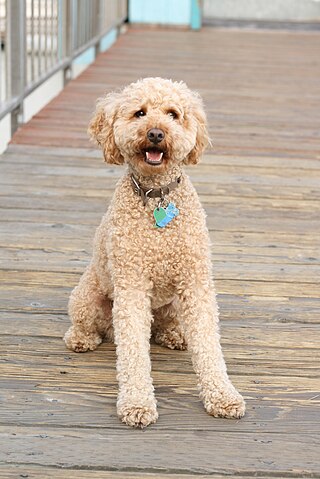
Dog crossbreeds, sometimes called designer dogs, are dogs which have been intentionally bred from two or more recognized dog breeds. They are not dogs with no purebred ancestors, but are not otherwise recognised as breeds in their own right, and do not necessarily breed true.
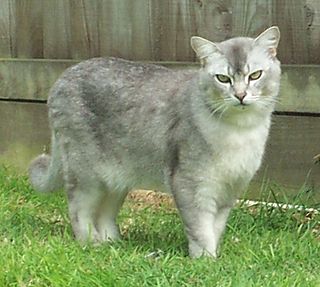
The Burmilla is a breed of domestic cat, that originated in the United Kingdom in 1981. It is a cross between the Chinchilla Persian and Burmese cats. In certain cat registries the breed falls under the Asian group, and is sometimes referred to as the Asian Shaded. Standards were produced in 1984, and the breed gained championship status in the United Kingdom in the 1990s.

The International Cat Association (TICA) is considered the world's largest genetic cat registry. Originally a North American organization, it now has a worldwide presence. The organization has a genetic registry for pedigreed and household pet cats and is one of the world's largest sanctioning bodies for cat shows.

The rex mutation is a genetic variation in mammals that results in soft curly fur. These effects are due to changes in the structure of groups of hairs and cross-section of individual hairs. The rexed coats are unusual but occur in cats, rats, rabbits, horses, and dogs. The mutations, infrequent and spontaneous, occur in a variety of genes and genetic regulatory structures. The diversity of genetic factors results in variable coat thickness/density and fur length. A similar mutation can affect the feathers of birds.
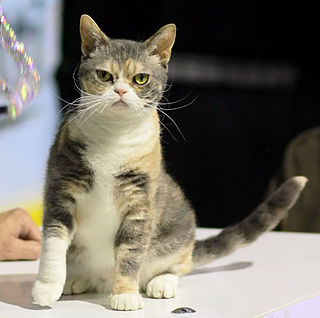
The American Wirehair is a breed of domestic cat originating in Staten Island New York, which is characterized by its wiry fur and crinkly whiskers caused by a genetic mutation. As of 2017, though the breed is well-known, it is ranked as the most rare of the 41 Cat Fanciers' Association breeds.
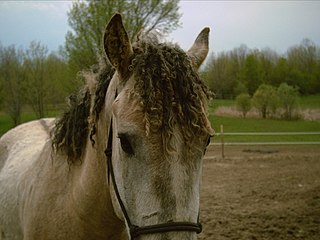
The American Bashkir Curly or North American Curly Horse is a North American breed of horse, characterized by an unusual curly coat of hair. It derives from American horses of Iberian origin, in which curly-coated individuals occasionally occur; it is unrelated to Asian horses such as the Bashkir and Lokai, which may also be curly-coated. The American Bashkir Curly has been extensively cross-bred with horses of other breeds, and varies widely in size and conformation; it may be of any color.
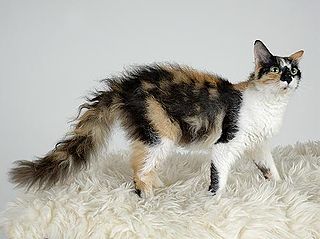
The LaPerm is a breed of cat. A LaPerm's fur is curly, with the tightest curls being on the throat and on the base of the ears. LaPerms come in many colors and patterns. LaPerms generally have a very affectionate personality.

An Oriental bicolour is any cat of Oriental type, either long-haired or short-haired and in any pattern including colourpoint, which has white areas on its coat caused by the white spotting gene. In most cat fancier and breeder organisations, Oriental bicolours do not constitute a standardised breed, but a coat pattern variant of the breed of their foundation stock. One breed registry is an exception, the UK-based Governing Council of the Cat Fancy (GCCF), which has defined them as a separate breed named Oriental Bicolour (capitalised).

The British Longhair is a medium-sized, semi-long-haired breed of domestic cat, originating in Great Britain.

The Canadian Cat Association is a non-profit organization in Canada whose mission is to promote the welfare of all cats in Canada, maintain a registry of pedigreed cats in Canada, and further the improvement of all breeds of cats in Canada. CCA-AFC is Canada's only globally-recognized national cat registry, with its pedigrees and registrations accepted by major global associations such as the Cat Fanciers' Association, The International Cat Association, and Fédération Internationale Féline. To date, CCA-AFC has registered over 190,000 cats.